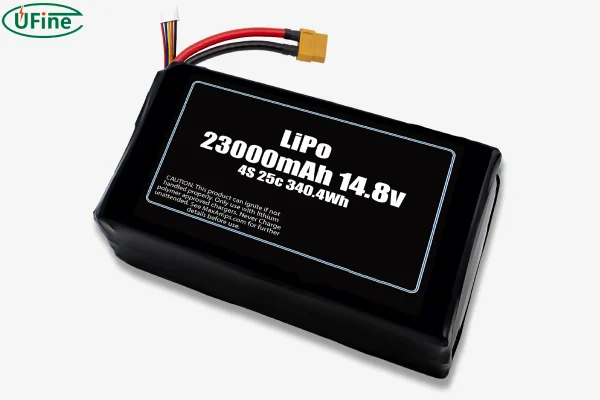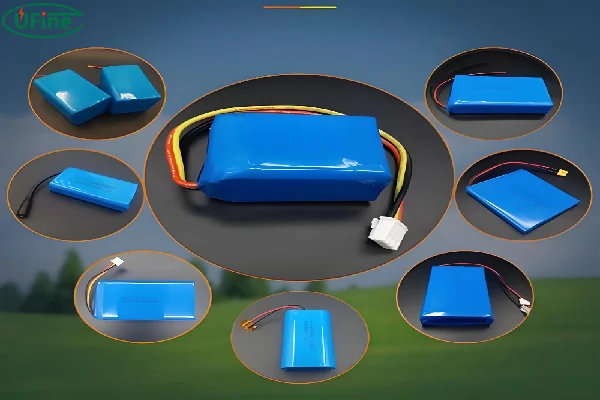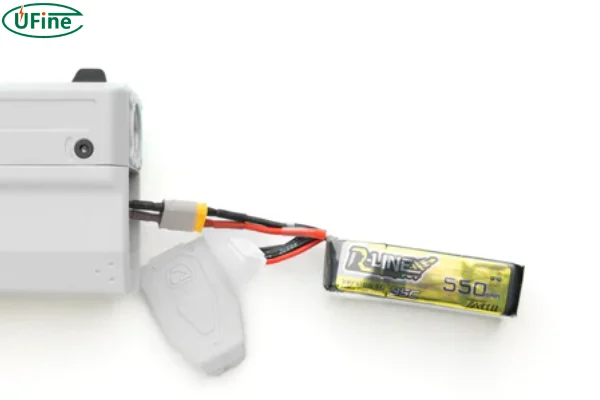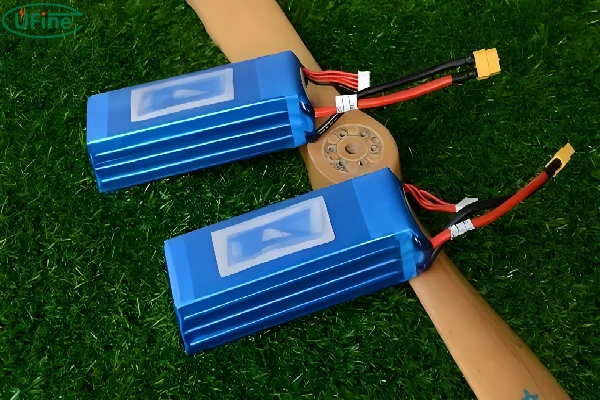
- Part 1. What does 4S mean on a LiPo battery?
- Part 2. 4S LiPo battery voltage
- Part 3. How long does a 4S LiPo battery last?
- Part 4. What affects the lifespan of a 4S LiPo battery?
- Part 5. Understanding lipo battery ratings
- Part 6 .Troubleshooting common issues with 4S lipo batteries
- Part 7.Tips for extending 4S lipo battery life
- Part 8. FAQs
What Is the Voltage of a 4S LiPo Battery?
Let’s quickly answer this question:
A fully charged 4S LiPo (Lithium Polymer) battery has a voltage of 16.8 volts (4.2V per cell × 4 cells). Its nominal voltage is 14.8 volts (3.7V × 4), and it should never be discharged below 12.0 volts (3.0V × 4) to avoid damage.
| Battery State | Voltage (Total) | Voltage per Cell |
|---|---|---|
| Fully Charged | 16.8V | 4.2V |
| Nominal (Average) | 14.8V | 3.7V |
| Minimum Safe Limit | 12.0V | 3.0V |
Part 1. What does 4S mean on a LiPo battery?

A 4S Lipo battery consists of four individual lithium polymer cells connected in series. Each cell typically has a nominal voltage of 3.7 volts, leading to a total nominal voltage of 14.8 volts for a 4S configuration. The voltage range, however, can fluctuate:
- Fully charged: Approximately 16.8 volts (4.2 volts per cell).
- Fully discharged: Approximately 12-13 volts (3-3.25 volts per cell).
Key Features
For users looking to leverage Lipo batteries optimally, understanding their key features is crucial:
- High Energy Density: Lipo batteries offer a great balance of energy and weight, allowing devices to run longer without adding unnecessary bulk.
- C-Rate (Discharge Rate): This indicates how quickly the battery can discharge its energy without degrading its performance. For example, a 30C battery can discharge at 30 times its capacity rate.
- Voltage Stability: These batteries maintain stable voltage levels, essential for maintaining consistent power supply to devices.
- Customizability: Various configurations and capacities are available to meet specific power requirements and constraints.
Part 2. 4S LiPo battery voltage
A 4S LiPo battery consists of four lithium polymer cells connected in series (that’s what the “4S” stands for). Each LiPo cell has a nominal voltage of 3.7 volts, so a 4S battery has a nominal voltage of 14.8V. However, voltage varies depending on the battery’s state of charge:
- When fully charged, each cell reaches 4.2V, giving a total of 16.8V.
- At 50% charge, the battery hovers around 14.8V, its nominal voltage.
- When fully discharged, each cell should not drop below 3.0V, resulting in a minimum safe voltage of 12.0V.
Discharging below 3.0V per cell risks permanent damage to the battery and can lead to swelling, capacity loss, or even safety hazards such as thermal runaway. That’s why it’s essential to use a LiPo-compatible battery monitor or ESC with low-voltage cutoff.
Part 3. How long does a 4S LiPo battery last?
When people ask, “how long does a 4S LiPo battery last?”, there are two interpretations of this question: runtime per charge and overall lifespan.
1. Runtime Per Charge
The runtime of a 4S LiPo battery on a single charge depends on:
- Battery capacity (mAh) — e.g., 1500mAh vs. 5000mAh
- Discharge rate (C-rating)
- Current draw of the device
- Use case (racing drone, FPV, RC car, etc.)
Typical usage estimates:
- 1500mAh 4S on a racing drone: 4–7 minutes of flight
- 2200mAh 4S in an RC plane: 8–15 minutes
- 5000mAh 4S in an RC car: 20–30 minutes under moderate load
To estimate runtime more accurately, use the formula:
Runtime (in hours) ≈ Capacity (Ah) ÷ Average Current Draw (A)
Example: A 4S 2200mAh battery (2.2Ah) running a 20A motor would last ≈ 0.11 hours or ~6.6 minutes.
2. Lifespan Over Time
A good-quality 4S LiPo battery typically lasts 150 to 300 full charge cycles with proper care. For hobbyists who fly or drive weekly, this translates to about 1–2 years of usable life. However, poor usage habits can reduce lifespan to fewer than 100 cycles.
Part 4. What affects the lifespan of a 4S LiPo battery?
LiPo battery degradation is a chemical process influenced by stress, temperature, and user habits. To maximize the lifespan of your 4S battery, you should understand the following key factors:
1. Depth of Discharge (DoD)
- The deeper you discharge a battery (especially below 3.5V per cell), the more wear it experiences.
- Keeping discharge levels above 20% remaining capacity (around 3.5V/cell) significantly extends cycle life.
2. Charge/Discharge Rates
- High C-rates (both for discharge and charging) stress the internal chemistry.
- Fast charging (e.g., >1C) generates more heat, shortening lifespan.
- Stick to 1C or lower for charging when possible.
3. Temperature
- High temperatures (above 60°C) accelerate chemical breakdown.
- Low temperatures reduce capacity temporarily and increase internal resistance.
- Ideal operating temperature: 20–40°C
- Always allow the battery to cool before recharging.
4. Storage Voltage
- Never store a LiPo fully charged (4.2V/cell) or fully discharged (<3.6V/cell).
- The optimal storage voltage is 3.7V to 3.85V per cell.
- Long-term improper storage is a common cause of puffed or degraded batteries.
5. Physical Damage or Swelling
- Mechanical impacts, overuse, or internal short circuits can cause swelling (gas buildup).
- A swollen battery is dangerous and should be properly disposed of immediately.
Part 5. Understanding lipo battery ratings
To effectively utilize 4S Lipo batteries, it is crucial to understand their ratings. These ratings indicate battery performance, safety, and compatibility with specific applications.
1. Voltage Rating
- Nominal Voltage: Each cell in a Lipo battery typically has a nominal voltage of 3.7 volts. Hence, a 4S (4-cell) Lipo battery will have a nominal voltage of 14.8 volts (3.7V x 4).
- Fully Charged Voltage: When fully charged, each cell can reach up to 4.2 volts, making the fully charged voltage of a 4S Lipo battery 16.8 volts (4.2V x 4).
- Safe Discharge Voltage: It is recommended not to discharge Lipo cells below 3.0 volts to prevent damage, meaning a 4S Lipo battery should not fall below 12 volts (3.0V x 4).
2. Capacity Rating
- Measured in milliampere-hours (mAh), this rating signifies the total charge the battery can hold.
- A higher capacity (e.g., 5000mAh) indicates a longer runtime compared to a lower capacity (e.g., 2200mAh) for the same applications.
- Users need to balance capacity with weight and size, especially for aerospace and mobile robotics applications.
3. Discharge Rating (C-Rating)
- The C-rating indicates the maximum safe continuous discharge rate.
- For instance, a 30C 2200mAh Lipo can continuously discharge 66 amps (30 x 2.2).
- Burst discharge rate, generally higher than the continuous rating, can only be sustained for short periods (usually a few seconds).
4. Configuration
- The “4S” nomenclature denotes the series configuration of cells within the battery pack, meaning 4 cells connected in series.
- Series connections increase voltage while maintaining the same capacity as a single cell.
5. Internal Resistance
- Lower internal resistance enhances battery efficiency and lifespan.
- High internal resistance can lead to higher heat generation and reduced performance.
Comprehending these ratings ensures correct battery selection and optimal performance. Always cross-reference the ratings with the requirements of the device in use to ensure compatibility and safety.
Part 6 .Troubleshooting common issues with 4S lipo batteries
Numerous issues may arise when dealing with 4S Lipo batteries. Understanding common problems and their solutions is critical for maintaining battery health and performance.
Overheating
Overheating can damage a 4S Lipo battery. Potential causes include overcharging, high discharge rates, and inadequate cooling.
- Check charging practices: Ensure chargers are used correctly and within specifications.
- Monitor discharge rates: Avoid drawing more current than the battery is rated for.
- Enhance cooling: Utilize heat sinks or cooling fans if necessary.
Swelling or Puffing
Swelling, also known as puffing, indicates internal damage or chemical instability.
- Inspect for damage: Check for visible physical damage or signs of misuse.
- Follow usage guidelines: Adhere to recommended charging and discharging practices.
- Dispose if necessary: Properly dispose of badly swollen batteries.
Voltage Imbalance
Voltage imbalance among cells can reduce battery efficiency and lifespan.
- Balance charging: Use a balance charger to ensure cells are charged evenly.
- Regular checks: Periodically check individual cell voltages.
- Manual balancing: Manually discharge higher voltage cells if required.
Connection Issues
Poor connections can lead to power loss or intermittent failure.
- Inspect solder joints: Verify all solder connections are intact.
- Check connectors: Ensure both connectors and wiring are secure.
- Clean contacts: Remove any debris or oxidation from connectors.
Rapid Discharge
Experiencing abnormally fast discharge might indicate underlying problems.
- Review usage: Avoid excessive current draw and improper battery loads.
- Test for firmware issues: Verify that device firmware and settings are appropriate.
- Evaluate health: Consider replacing the battery if performance degradation persists.
Storage Problems
Improper storage can shorten battery lifespan.
- Store at optimal voltage: Maintain a storage charge of approximately 3.8V per cell.
- Control environment: Store in a cool, dry place.
- Periodically check: Regularly monitor battery voltage during long-term storage.
Leakage
A leaking battery poses significant dangers.
- Immediate isolation: Safely isolate the leaking battery.
- Cleanup: Follow appropriate hazardous material cleanup procedures.
- Replacement: Replace the battery immediately.
Part 7.Tips for extending 4S lipo battery life
To maximize the lifespan of a 4S Lipo battery, follow these essential tips:
Proper Charging Practices
- Use a Balanced Charger: Employing a balance charger ensures each cell within the battery is charged evenly, helping to prevent overcharging or undercharging individual cells.
- Set Correct Charging Rates: Always follow the manufacturer’s recommended charging rates. Typically, charging at 1C is considered safe, but always refer to the specific battery specifications.
- Avoid Overcharging: Do not charge the battery above 4.2V per cell. Overcharging can lead to swelling, overheating, and potentially fire.
Safe Storage
- Store at Correct Voltage: For long-term storage, keep the battery at a storage voltage of approximately 3.8V to 3.85V per cell to reduce stress on the cells.
- Use Storage Mode on Charger: Many balance chargers have a storage mode setting to automatically bring the battery to a safe voltage level for storage.
- Cool, Dry Environment: Store batteries in a cool, dry place away from direct sunlight and extreme temperatures to prevent degradation and potential hazards.
Handling and Usage
- Avoid Deep Discharges: Do not discharge the battery below 3.0V per cell. Deep discharging can cause irreversible damage and reduce overall lifespan.
- Monitor Temperatures: During use, ensure that the battery does not overheat. Excessive heat can reduce the life and efficiency of the battery. Post-flight, allow the battery to cool before charging.
- Use Voltage Alarms: Voltage alarms can alert the user if the battery voltage drops to unsafe levels during use, allowing timely intervention.
Regular Maintenance
- Check for Damage: Regularly inspect the battery for signs of physical damage, swelling, or leakage. Dispose of damaged batteries responsibly.
- Cycle the Battery: Occasionally cycle the battery by fully charging and discharging it to recalibrate the cells and improve performance.
- Balance Charge Regularly: Even if not frequently used, occasionally balance charge the battery to maintain cell health.
Part 8. FAQs
How long does a 4S LiPo battery last?
4S LiPo battery typically lasts 150–300 charge cycles with proper care. On a single charge, it can run for 5 to 30 minutes, depending on capacity, current draw, and usage.
Which is better, a 4S or 6S LiPo battery?
A 6S LiPo battery offers more power and efficiency due to higher voltage, making it ideal for racing drones or high-performance builds. However, 4S batteries are lighter, cheaper, and sufficient for most hobby use. The best choice depends on your setup and performance goals.
Which is better, a 3S or 4S battery?
A 4S battery provides more power and faster response than a 3S, which can improve speed and agility in drones or RC vehicles. However, 3S batteries are gentler on components and often more beginner-friendly. Choose based on your system’s voltage tolerance and performance needs.
Related Tags:
More Articles

Battery Load Test: A Comprehensive Guide
Step-by-step battery load test guide for car, solar & industrial use. Learn how to load test a battery, interpret voltage charts, and avoid common mistakes.
The Comprehensive Guide to Battery Balancing and Battery Balancer
Discover how battery balancers improve lithium battery performance, lifespan, and safety. Learn types, functions, and tips to choose the right balancer.
What Is the Best Voltage for a Chainsaw Battery?
Compare 12V-80V chainsaw batteries for light pruning, medium firewood, and professional cutting. See best battery chainsaw with runtime charts and safety tips.
Lithium VS. Alkaline Batteries: A Comprehensive Comparison
Lithium batteries last 3–7× longer than alkaline and perform better in cold weather. Compare lifespan, cost, safety, and best uses to choose the right battery.
Comparing Lithium-Sulfur and Lithium-Ion Batteries: Which is Right for You?
Compare lithium-sulfur (Li-S) and lithium-ion batteries on energy, lifespan, cost, safety, and applications. Best choice for drones, EVs, and electronics.





